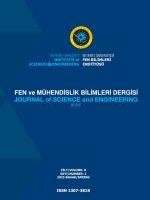AN ONTOLOGY DESIGN TO REPRESENT ACADEMIC RESEARCHES
Ontology, semantic web, conceptualization, knowledge representation, SPARQL
An Ontology Design to Represent Academic Researches
Ontology, semantic web, conceptualization, knowledge representation, SPARQL,
___
- [1] Gruber,T:Ontology to appear in the Encyclopedia of Database Systems, Liu,L., Ozsu, M.T. (Eds.), Springer-Verlag, 2008.(2007). http://tomgruber.org/writing/ontology-definiton-2007.html
- [2] Borst, W:Construction of engineering ontologies for knowledge sharing and reuse, PhD. thesis, University of Enschede (1997).
- [3] Gruber, T : A translation approach to portable ontology specifications, Knowledge Acquisition 5(2) (1993)199-220.
- [4] Tillet, B : What is FRBR? A conceptual model for the bibliographic universe, 2004, library of Congress cataloging distribution service.
- [5] Studer,R.,Benjamins,V.R.,Fensel,D.: Knowledge engineering: principles and methods, Data&Knowledge engineering 25 (1-2) (1998) 161-197.
- [6] Tang,M.T.,Toussaint,Y.: Introducing metrics in the lattice to build ontology (2014).
- [7] Sowa, F : The role of logic and ontology in language and reasoning,Springer, Netherlands,Dordrecht,2010,pp.231-263.doi:10.1007/978-90-481-8845-1_11.
- [8] Lickly, B.:Static model analysis with lattice-based ontologies,PhD. thesis, EECS Department, University of California, Berkeley(Nov 2012). http://www2.eecs.berkeley.edu/Pubs/TechRpts/2012/EECS-2012-212.html.
- [9] Grosof, B.,Volz,R., Horrocks, I.,Deckers,S.:Description logic programs: combining logic programs with description logic,in:Proceeding of 12th International Conference on World Wide Web, 2003.
- [10] Krotzsch,M., Simancik, F.,Horrocks,I,: Description logics, IEEE Intelligent Systems 29 (1) (2014) 12-19.
- [11] Giordano,L., Gliozzi,V.:Encoding a preferential extension of the description logic sroiq into sroiq,in: Esposito,F, Pivert,O, Hacid,M-S, Ras,Z.W, S.Ferilli, (Eds.)ISMIS Vol. 9384 of lecture notes in Computer Science, Springer,2015,pp.248-258.
- ISSN: 1307-3818
- Başlangıç: 2007
- Yayıncı: Beykent Üniversitesi
DALIŞ SİSTEMLERİNE FARKLI VE YENİLİKÇİ BİR YAKLAŞIM
Kerem URCAN, Tuba KARAHAN, Sunullah ÖZBEK
TÜRKİYE’DE ÜRETİM/İŞLEMLER YÖNETİMİ (ÜİY) EĞİTİMİNE İLİŞKİN AMPİRİK BİR ÇALIŞMA
Bülent ÇEKİÇ, Mine ÖMÜRGÖNÜLŞEN
ÜRETİCİ SEÇİM PROBLEMİ: TÜRK GIDA SEKTÖRÜNDEN BİR ÖRNEK
TESSARİNELER İLE HOMOTETİK HAREKETLERE ?? ? YARI- ÖKLİD UZAYINDA YENİ BİR YAKLAŞIM
AN ONTOLOGY DESIGN TO REPRESENT ACADEMIC RESEARCHES
VERİMLİ VE TEPKİSEL TEDARİK ZİNCİRLERİNDE FARKLI UYGULAMALARIN ZİNCİR PERFORMANSINA ETKİLERİ
